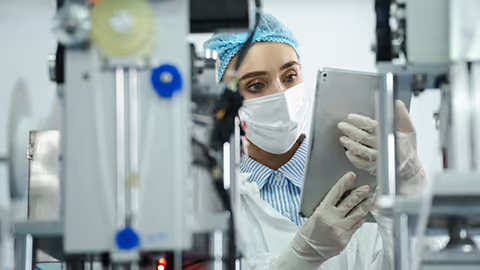As patient numbers grow, traditional means of ensuring manufacturing reliability will no longer be adequate. The reliable delivery of autologous cell products for larger numbers of patients is therefore as much an engineering challenge as it is a biological challenge.
In autologous cell therapy, the patient’s own cells are cultured, genetically engineered and expanded outside the body in small, individual batches, bespoke to each patient, before being reintroduced into the body, for example to attack a tumour. This therapeutic approach places new demands on the manufacturing equipment needed to deliver this product. With traditional biologics, one scales up the liquid volume of the equipment to increase production capacity. Such systems are relatively simple to engineer for reliability and subsequently qualify through testing. With autologous cell products, production capacity is generally scaled up by increasing the number of manufacturing systems. This presents new challenges for manufacturing reliability because of the large number of systems, a high total part count and resulting challenges in system qualification. Given that reduced reliability and lost production runs are not an option in autologous cell therapy, what can cell therapy developers do to address this challenge?
Traditional bioprocess manufacturing
When manufacturing biologics, liquid volumes typically increase during product development. The final manufacturing process is often similar to the development process but uses equipment capable of handling much larger liquid volumes. The final manufacturing systems, whilst capable of handling large volumes, are simply scaled up versions of the development equipment and therefore have a relative modest part count.
The final manufacturing equipment is designed to take into consideration its use in high volume production and as such is engineered to higher reliability than its development counterparts. This can usually be achieved by overengineering key components. In the case of reusable bioreactors, this can be supplemented by in depth testing by both the equipment supplier and the biologics manufacturer. Such testing often consists of qualification runs over a period of weeks or months.
Autologous cell therapies
Manufacturing equipment for autologous cell therapy follows a different development path. Because the liquid volumes in each production run are the same in both development and final manufacturing, there is no need for scaled-up equipment. The good news is that this means the final manufacturing system can potentially be very similar to the development equipment. However, to achieve commercial scale, that is to deliver autologous cell products for many patients, we will need many more systems than we used in development – so-called scale-out rather than scale-up.
This creates challenges in terms of both part count and system qualification. Despite the difference in liquid volumes, large and small volume manufacturing systems both have similar part counts. What this means is that when we scale-out autologous manufacture to 1000 systems, we also have 1000 times more parts. And if we use the traditional qualification route where each manufacturing system is separately qualified, we now have 1000 times more qualification runs to conduct. In addition, if we are using single use consumables, the number of consumables we are using has also gone up by 1000 times. Suddenly, low failure rates can give rise to frequent problems, simply due to scale.
In autologous cell therapies this problem is compounded by the fact that each production run is unique to a given patient and successful and timely delivery of therapy is critical. Losing a batch of traditional biologic is commercially undesirable. Losing a batch of an autologous cell therapy could mean patient death.
How many production runs could we lose?
Let’s begin with the traditional bioprocess. To keep it simple, let’s assume we have a system which has 10 critical parts, the failure of any one of which causes a system failure. Each of these has a random failure rate so that any one component fails on average once every 10 years. Another way to say this is that each critical component has a Mean Time Between Failure (MTBF) of 10 years. But because we have 10 such components we have a MTBF of the total system of 1 year (a 10 year component MTBF divided by the number of components). Of course, we hope most of our failure distributions are shifted so that that failures are more likely as components age. So, we may hope to get 2 or 3 years of trouble-free operation, then problems every 6 months thereafter.
Now, consider the process for making batches of autologous cell therapy where we have 1000 such systems. And let us assume we have managed to qualify these 1000 systems as well as our single large system, which is a best-case scenario. Each of our 1000 systems will have the same failure rate as before, but because our manufacturing facility houses 1000 systems, we will have 1000 times more failures. We could see 3 production runs fail on our first day!
Suddenly that 10 year component MTBF doesn’t seem adequate and the need to reduce the count of critical components comes sharply into focus.
What about the consumables?
Autologous cell therapy manufacturing at scale faces a further challenge beyond MTBF and system reliability and that arises from part dimensional tolerances. Despite our desire to place rigid tolerance limits on parts, we know that more often than not dimensional variation follows a distribution. With a small number of parts, our chances of encountering parts in the tail of the distribution outside of our specification limit is small. As the number of parts increases so does the chance of seeing those out-of-spec parts.
For example, let us assume our manufacturing system relies on single use consumables. Our consumable is an assembly of tubes, bags, septums etc. which, to keep the maths simple, consists of 10 parts that are all critical to function. Now let us assume each part has 10 critical dimensions and if any of these are out of spec, then there will be a system failure. In total our consumable has 100 critical dimensions.
We’ll assume our consumable manufacturing is good and able to hold a six sigma tolerance level (or a 3.4 part per million failure rate). For a system with 100 critical dimensions, this gives about a 1:3000 chance of any one dimension in our consumable being out of spec.
If our manufacturing process takes 1 week, a traditional bioprocess we will use 52 consumables a year. This means it will take nearly 60 years to get through enough consumables to see a failure. But in the autologous process, where we going through 1000 consumables every week, we will see on average one failure every month.
Clearly the numbers here have been selected to illustrate a point. However, there is no getting away from the fundamental problem that many more systems means many more problems.
How can we address this challenge?
The good news is that analysing and solving these problems is normal practice in the medical device sector. This has allowed the medical device industry to succeed in producing reliable, safe products in very high volumes. By ensuring the critical part count is reduced, MTBFs can be managed down. By reducing the number of critical dimensions, failure rates can be reduced. Powerful statistical and probabilistic modelling techniques can be applied to accurately predict the impact of dimensional tolerances on a design to make it inherently more reliable. Statistical tools can be used to validate manufactured populations of parts to ensure the predictions are accurate. For autologous cell therapies, manufacturers may need to employ such considerations during the development of their manufacturing equipment to achieve adequate levels of production reliability.
Whilst cell therapy developers have previously been able to validate manufacturing equipment in the manner of traditional bioprocesses, the large number of systems and disposables required for scaled out autologous cell therapy manufacture makes it much harder to prove that equipment is acceptable. Cell therapy has relied heavily on repurposed R&D equipment to get it where it is today. This is fit for the current purpose, but as volumes go up it is likely that unacceptable failure rates will hit production. Given the challenges of testing for these levels of failure rates, therapy developers should be looking to address this in design. Therapy producers will need to work with equipment manufactures to ensure they are not incubating problems for the future.











